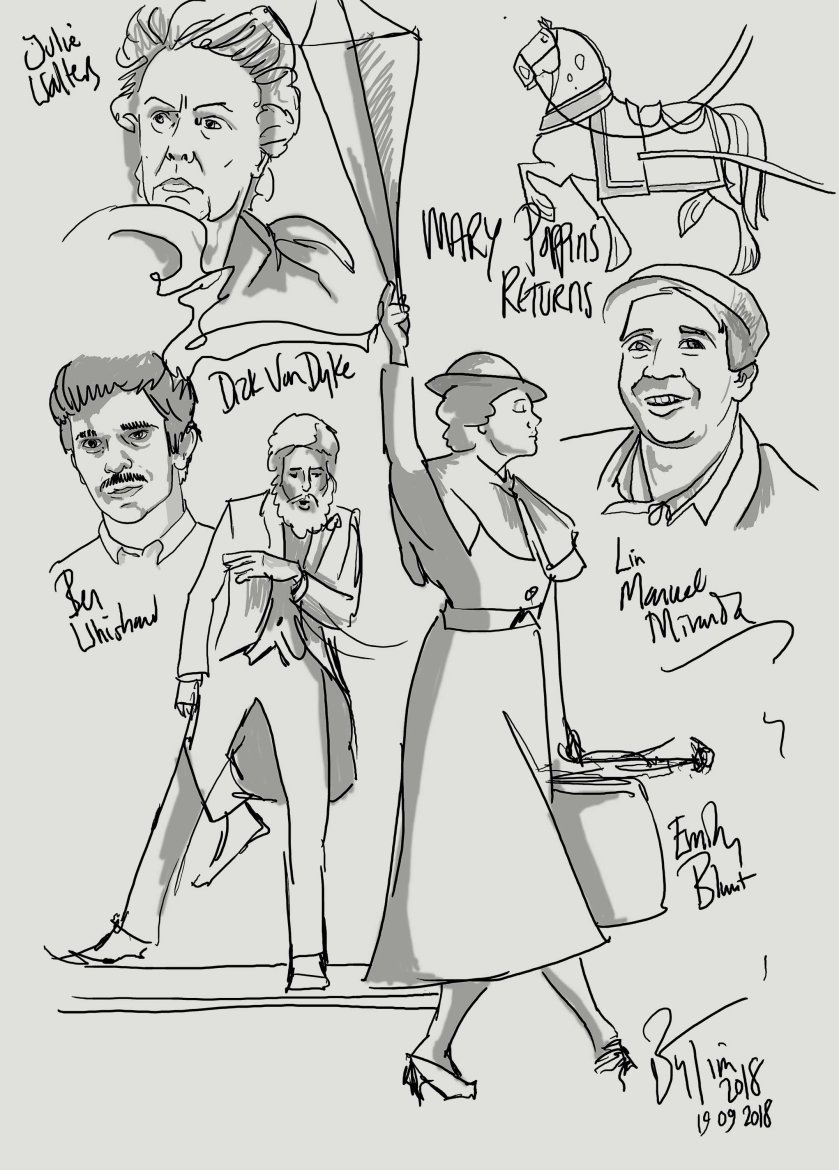The role of Mr Banks is central to Mary Poppins. This is the message of “Saving Mr Banks” but it is not necessarily the original message of the 1964 film and a good deal of re-packaging has gone on which, of course, has continued into the making of “Mary Poppins Returns”. It is not Banks who is central to the film but the bricolage of liberal Christianity and new technology. Banks is incidental.
The original Mary Poppins was set in the depression, at the time when the film sequel takes place. But Travers’ was not writing a piece of nostalgia. Her book has a contemporary feel about it because it was written in 1934, slap-bang in the period in which it is set even if she was to revise some of the characters later in 1967. Disney’s choice of pushing the setting back into Edwardian England has elements of whimsey to it, but it serves to make an interesting comment on the period from 1961-1964 when the film was in production. Mr Banks sets himself up as a model of the new economy, in a man’s world; he will also go on later to extol the virtues of Imperial commerce. But there is irony in his virtues as his world is will collapse in the war. His stiff-upper lip and patriarchal values are also directly challenged by Mary Poppins’ mixture of practical self-reliance and her virtues of helping the poor, responding to odd emergencies (even if that puts the day’s fish-mongering on hold) as well as honest escapism.
In America, the certainties of Eisenhower have given way to the Kennedy’s assassination and the rise of a flower-power revolt against Vietnam. Disney found a way to make a family film that implicitly questioned power and bizarrely reflected the age in which it was made. If Banks was blinded by jingoism, America was blinded by a Cold War ideology and a belief that it was still engaged in a conventional conflict that could be won.
More than that, Mary Poppins promoted change. At a time when the big studios were failing, Disney offered itself as the studio of innovation, developing a new travelling matte process to better any on offer in Hollywood, as well as providing a fresh take on genre when studio fare was stagnating. Disney mixed musical and comedy (done before) with animation; it embraced tv, creating a film star out of the tv sensation that was Dick van Dyke; it also mixed a film for children with a high-budget ritzy road-show premiere, generating a merchandise bonanza in brochures, dolls, rugs, jigsaws, comic adaptations and LP records. As a result of Mary Poppins, the bigscreen musicals had one last decade of success and the fantasy genre emerged out of both the new technology together with the Disney chutzpah of pumping millions into what would earlier have been dismissed as children’s entertainment. There would be no Star Wars were it not for Mary Poppins.
Mary Poppins also drew on a new form of Christianity ushered in by the pontificates of John XXIII and Paul VI and the Second Vatican Council. the new Christianity of personal freedom and social transformation are clear in Mary Poppins the Disney film. This is a film where the religious message transforms or irradiates the world.
The film opens with Mary Poppins seated on a cloud. The iconography is slightly undermined by rehashing an old Disney joke – the umbrella sinking into the cloud which is a visual borrowed from 1941’s Dumbo. She will call herself “practically perfect”, the Immaculate conception. Other women have succumbed to sin, she has not. Like Mary, she ushers in a new age, blowing away the nannies of the past.
Mary’s freedom is not without rules. She promotes personal responsibility (as in Mary Poppins Returns: “cleaning is not a spectator sport”) and whether work or play, everything is didactic. As with St Therese of Lisieux, one of the saints particularly promoted by the new Popes, the little acts of kindness, the incidental process of tidying up, what she calls “mundane acts of love.., the nothingness of here and now may be transformed into fire.” But there is more to Mary’s freedom. It is something that she presides over, but essentially again and again, it is the children, Bert, the domestics and so on, who are actually transformed by doing something. This is the laity in action, the message promoted by people like Francis of Assisi. It was also the ideology of Vatican II.

The film shows gives us a vision of a society that is accessible, that is on the edge of the sublime, that is in transformation, where reality is constantly tinged with fantasy. Finding God is about finding one another. there is a dissolve between the cathedral and Mary Poppins herself during the Feed the Birds song that sums up the message I think Disney was going for. The Christian message is transcendent and immanent at the same time. It is both architectural and personal. Mary emerges in this transition as a quasi-icon and if we wonder why only saints and apostles are mentioned in the song- and not angels too. Well, in this instance, Mary is the angel or at least the voice of an angel.
Francis is also there in the joy and music that surround Mary Poppins. He is there in the conversations with animals and particularly in the imagery conjured up in the song “Feed the Birds” which links the two themes- the stewardship of nature and at the same time, helping the poor.
Money is significant in the plot. Tuppence is used 4 times, first to feed the birds, then to invest in the bank, the foundation of capitalism and the Imperial vision George Banks has already given us at the start of the film, then it is redemptive when the children give their father the tuppence (the widow’s mite) and finally the tuppence is given to Mr Dawes as an apparent rejection of capitalism (Mark 12:17- render unto Caesar). The tuppence emerges again, of course, in “Mary Poppins Returns” as an improbable bit of economic magic, and a gentle dig at the parable of the talents.
When Winnifred joins the family again, and ties her banner to the kite, she is not really rejecting one life and taking up another. She is combining the two, and might even be anticipating liberation theology. This vacillation also proves to be the case with her husband too. His attempted rejection of mammon in the bank is thwarted by the death of old man Dawes and an opening for a new partner in the bank.
Mary leaves by talking umbrella, but she does not simply ascend. Instead, she travels across a london landscape like the spirit of manifest destiny spreading a little progress as she goes. The angel in the famous painting by John Gast was trailing an electricity cable- and no doubt Mary Poppins is leaving us a brighter form of technicolour.
“Don’t stay away too long” calls Bert. During production, Hitchcock was already using her technology to film key scenes in The Birds.



 Here are some sketches from watching the trailer of Mary Poppins returns along with two youtube links-
Here are some sketches from watching the trailer of Mary Poppins returns along with two youtube links-





